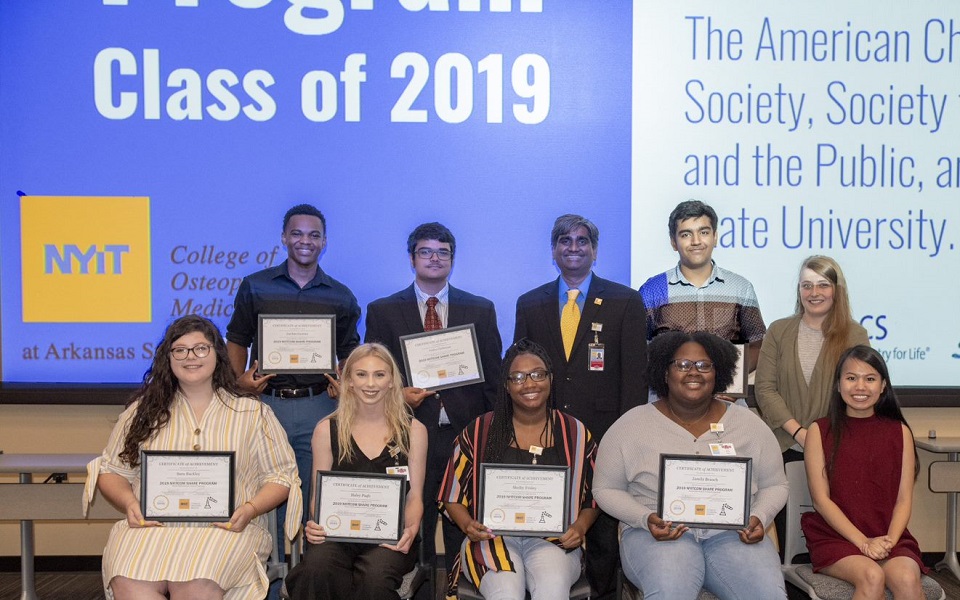Advocate Program, STEM Outreach
How one Society Advocate created a summer research program

Summer learning can be extremely beneficial to students looking to hone their STEM skills, but not all can dedicate two months of their time to pursuing research. Many may have other responsibilities that preclude their participation. Raj Rajnarayanan, Assistant Dean of Research and Associate Professor of Basic Sciences at the New York Institute of Technology College of Osteopathic Medicine (NYITCOM) at Arkansas State University, wanted to address this challenge. As a Society Advocate in 2019-2020, he created a paid summer internship program as a way to allow high school students to support their families while giving them an opportunity to gain laboratory exposure. The Society’s Advocate Program provides educators with training, stipends and year-round support to mentor students of underrepresented race or ethnicity or from low income households in entering science research competitions. While many Advocates lead students in research, which will be especially important to tailor in distance learning models, the main goal of this program is to increase and diversify participation in the Society’s STEM competitions and beyond. We recently caught up with Raj to learn more about how he leveraged his university connections to support student research. Read on for his insights below.
How was your overall experience being an Advocate? What’s the value of being part of such a program?
Science advocacy is not optional anymore. It is a responsibility. I have been an advocate for science without a tag or a label for over 20 years now. Doing it alone or as a small group has its own set of limitations. When I became a part of the Society’s Advocate Program, and more importantly the official “Advocate” title, it rebooted me, rejuvenated me and provided me with various tools, including a network of other advocates with a singular mission to increase STEM participation across the globe! The ability to brainstorm with teachers and scientists from different parts of the country is an added bonus. Further, the visit to Capitol Hill and meeting with congressional aides to discuss various initiatives and the status of science funding in our state was fruitful.
What inspired you to create a summer internship program? Why are student stipends important?
I had the privilege of working with top scientists and teachers who played a major role in my career. I am still am in touch with them, brainstorming ideas and seeking advice before making major career moves. It’s a big support system. I want every one of my students to have that experience and exposure!
I strongly believe how you spend your summer plays a major role in defining your career. Summer is a big chunk of time that can be used to develop and master crucial skills to succeed in academia (and life). At the same time, it is a luxury. Not everyone is free during the summer. Many students work full-time during the summer and ultimately miss out on a variety of wonderful professional development activities. This is the situation for a majority of students coming from economically disadvantaged backgrounds. I wanted to free their summer time and have them participate in an eight-week program called SHARE (Summer Health Academy for Research Exploration).
What type(s) of research/projects are your students involved in?
Projects ranged from building 3D bio-printers to modeling dinosaurs to monitoring chemical reactions using spectroscopy to looking at chronic pain models. Faculty mentors from ASU or NYITCOM were picked based on student interests and career aspirations. Students had the opportunity to interact with the entire research team on a regular basis. All students presented their projects before the entire institution, their parents and relatives. It was an emotional moment!
How has the coronavirus pandemic impacted you and your students? Can you share some ways you were able to adapt to a virtual learning format?
Having several campuses across the country, it was part of our daily routine to have interactive virtual sessions. It was an easy transition! Our IT department was able to help our local community and schools to adapt to a virtual platform seamlessly.
Communications with some of our high school scholars were challenging initially, since everything was delivered via online platforms. There were scheduling, logistical and technological issues, but we didn’t give up. We had to figure out a way to communicate regularly. The digital divide is real. Internet access is still in issue in many parts of Arkansas.
How do you think we can engage and retain more students of underrepresented race or ethnicity in STEM fields?
I have developed several federally-funded programs to increase student diversity at the undergraduate and graduate/professional school levels. The recipe is the same—recruitment has to be intentional and the program has to be focused. Developing a pipeline and having a critical mass of students from diverse backgrounds participate in a program that offers continued support beyond the summer is crucial. The network, the mentoring, the comradery amongst participants are the key ingredients. Looking at role models from the community consistently has its impact as well.
For the 2020-2021 school year, the Society’s Advocate Program pivoted to better support educators mentoring students who may be conducting their research at home due to COVID-19 shutdowns. Find out more about this year’s Advocates here.


